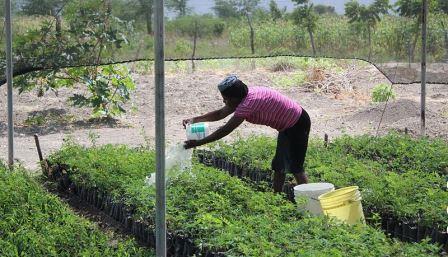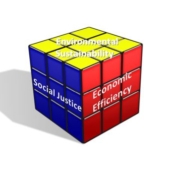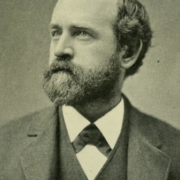Wealth Transfers, Carbon Dioxide Removal, and the Steady State Economy
by Brian Snyder
In 2019, the U.S. per capita GDP was $65,000. It seems obvious that this level of economic activity is more than sufficient to meet the needs of the U.S. population; after all, if we can’t live fulfilled, productive lives in an economy producing $65,000 per person per year, more money and production will never be enough. Further, additional per capita economic growth in the USA is uneconomic. For example, economic growth to $75,000 per person per year will not increase our economic wellbeing nearly as much as it will decrease ecological wellbeing; hence, the justification for a steady state economy.
But much of the world is not like the USA. Afghanistan’s per capita GDP was $502 in 2019. Burundi’s was $261, and the average per capita GDP in sub-Saharan Africa was less than $1600. In these nations, most citizens cannot meet their basic needs—food, water, sanitation, electricity, education, and healthcare—at current levels of economic activity. In these places, a steady state economy is unsustainable because poverty is unsustainable.

Poverty and an uneven distribution of wealth are major factors of the Syrian Civil War. (CC BY 2.0, Freedom)
There are two reasons we may consider poverty unsustainable. The first is simply definitional. One of my favorite definitions of sustainability is “meeting the needs of the present without compromising the ability of future generations to meet their own needs.” While this definition was originally used by the Brundtland Commission for “sustainable development” rather than “sustainability,” it works just as well for either. Given this definition, poverty is unsustainable because it does not allow for present generations to meet their basic needs.
But there is also a more fundamental reason why poverty is unsustainable, and it has less to do with poverty per se than the unequal distribution of wealth. If we consider sustainability to be “able to be sustained” or “able to be repeated for long periods,” then poverty itself is actually quite sustainable. Almost every human in history has lived in what we would consider abject poverty and could continue to do so for millennia.
Yet while poverty may be sustained over long periods, a vastly uneven distribution of wealth cannot; just ask Marie Antoinette or Tsar Nicholas II. While the French and Soviet Revolutions were, in part, a reaction to the inequal distribution of wealth and extreme poverty within a country, unequal power and wealth between nations can also fuel international rivalries, terrorism, and wars, all of which are unsustainable regardless of the definition you choose. A large part of the reason that Afghanistan and Somalia have been fertile soil for terrorism over the last three decades is that they are some of the poorest nations on Earth. Likewise, intranational economic inequality and poverty is an important cause of the Syrian Civil War, the deadliest conflict of the 21st century.
In sum, poverty and the unequal distribution of wealth between nations is unsustainable, and per capita GDP growth is required in the developing world to rectify it. Without such growth, asymmetries in wealth will continue to incite violence.
CDR Systems as a Solution
If we agree that economic growth is counterproductive in wealthy nations yet productive in poor nations, we may then ask which policies will be useful for transferring economic growth from the developed to the developing world. One obvious alternative is to transfer wealth from rich countries to poor countries. However, if this wealth is used to invest in industries, especially extractive industries, such wealth transfers may become counterproductive. For example, imagine that the developed world provides $100 million in cash to country X to build a factory that exports goods to developed markets. In this case, the developed world may benefit from cheap goods, facilitating economic growth in the developed world and defeating the purpose of the transfer. In other words, creating more low-cost production centers in a Western-financed race to the bottom is not in anyone’s interest.

Reforestation in Haiti. (CC BY-SA 4.0, Cunningchrisw)
Instead, we need to find a cash flow that facilitates economic growth in the developing world without creating economic growth in the developed world. Given that the economies of poor and rich nations are intertwined, this is unlikely to be possible, but there may be industries that could be targeted and developed that come close. One possibility is investments in carbon dioxide removal (CDR) systems financed with developed-world cash and using developing-world labor and land.
CDR, also called negative emissions technologies, are systems that use energy to remove carbon dioxide from the atmosphere. CDR systems range in technology from very low tech (like reforestation) to very high tech (like direct air carbon capture), and, at first glance, might not be the sort of thing many steady staters are inclined to support. After all, steady-state folks tend toward technological moderation and generally favor halting consumption growth, rather than developing new, often energy-intensive means for mitigating the impacts of consumption. Further, many CDR systems are likely to be unworkable or create larger problems than they solve. Hence, some skepticism is warranted.
But many CDR systems have considerable potential. Reforestation stores carbon and produces ecosystem services like soil protection, water retention, and wildlife habitat provision. Some bioenergy with carbon capture and storage systems may likewise produce ecosystem services if the biomass is harvested and managed sustainably. Enhanced weathering also is promising as a low energy means for sequestering carbon. And while direct air carbon capture systems are energy intensive, that energy could be supplied by renewable resources, especially in parts of sub-Saharan Africa with exceptional solar resources.
Furthermore, CDR is likely the only plausible path toward meeting the Paris commitments. To limit the temperature increase to 1.5°C, we need to be at about net zero CO2 emissions in 30 years and achieve net negative emissions in the last decades of the 21st century. Because of our dependence on fossil fuels in industrial and power applications, it is highly unlikely that our gross emissions of CO2 will be zero around 2050. We would need some negative emissions to achieve a net zero emission. In other words, even if we decarbonize rapidly, it likely won’t be enough.
The Function of Wealth Transfers and CDR

Jeff Bezos has accumulated hundreds of billions of dollars. Image how many countries could be supported on his income alone. (CC BY 2.0, Seattle City Council)
Consider a policy in which developed-world nations transfer wealth to the developing world for investments in CDR systems. This wealth transfer would act like a tax in the developed world, potentially reducing economic growth. Of course, some portion of this wealth transfer will return back to the developed world for purchasing technology for CDR implementation, subverting the purpose of increasing growth in the developing world without increasing growth in the developed world. Yet much of the wealth will be used to pay for labor in the developed world, especially in lower-tech CDR systems like reforestation and biomass-based systems. If much of the wealth from the policy stays in the developing world and isn’t used to buy developed-world goods and services, the policy may be effective at transferring wealth.
The use of wealth transfers to fund CDR has an advantage that less targeted wealth transfers do not have because CDR is, in a sense, parasitic. CDR does not produce something of value that can be sold in the same way that a factory or a coal mine does. Instead, it consumes wealth to produce a theoretical emissions credit that can only have value because governments require them. The physical “thing” itself, stored carbon, has no value—especially in its oxidized form stored in underground formations. Thus, CDR systems are akin to wealth furnaces that take land, labor, and capital and turn them into nothing that can be used to stimulate economic growth in the developed world.
We can think of investing in CDR as akin to investing in sanitation. Like sanitation, CDR produces a public good that is absolutely necessary, but funding it serves as an inefficiency for the economy. By tying CDR with wealth transfers, we may be able to increase this inefficiency, and thus slow growth, for the developed world while creating employment and infrastructure in the developing world.
A Just Transition
The nations of the developing world did nearly nothing to cause climate change, yet they are likely to bear a disproportionate share of the burden of the direct impacts of climate change and the indirect economic impacts of decarbonization. Not only are poorer countries less able to adapt to climate change, but by using up the carbon budget, wealthy nations have effectively foreclosed poorer nations’ abilities to extract and use their own fossil fuels.
As mentioned above, the transfer of wealth will help to rectify this injustice, but we need a means to determine how much money to transfer. One possibility is to use a climate easement system in which developing-world nations are compensated for the lost value of their hydrocarbon resources. In such a policy, nations may estimate the net value of their hydrocarbon resources and enter into easements with wealthy nations that compensate them for their lost value and ensure that the resources remain underground.
Climate and Energy are Not Just Developed World Problems
In discussions about climate policy, we tend to focus on wealthy emitters—the USA, China, Europe—and ignore the developing world. This makes sense because it is how we have dealt with nearly every international problem in history: The rich people get together and make decisions, and the poor people get ignored. But energy and climate are the glue that binds us all together. We cannot craft an energy and climate policy that ignores the developing world because, if we do, developing-world nations will either develop into major emitters or remain mired in poverty, susceptible to conflict as temperatures rise and resources decline. Thus, we need a climate and energy policy that includes an explicit path toward sustainable development (as opposed to unsustainable growth) for the developing world. Without such a path, climate policy will fail.
 Brian Snyder is an assistant professor of environmental science at Louisiana State University and CASSE’s LSU Chapter director.
Brian Snyder is an assistant professor of environmental science at Louisiana State University and CASSE’s LSU Chapter director.







Hey, I’m all in favor of CDR by reforestation, or better yet leaving natural forests alone to grow and continue to sequester carbon. But schemes that involve cutting down all the native vegetation (and destroying all the wildlife) to plant tree plantations to then cut them down and BURN them to use the “energy” to supposedly capture the CO2 (which was already embodied in the original vegetative cover and released when it was destroyed) with unproven technology–that’s just nuts! But it’s a big “investment opportunity” for the ignorant, encouraging a big land grab that will further impoverish the Biosphere!
Hi Ronnie, I totally agree! There are good CDR systems and bad CDR systems and I would lump anything that causes deforestation in with the latter. That said, I also think there can be BECCS systems that produce ecosystem services and carbon storage. For example, Dave Tillman’s work on low-input high diversity grasslands. We could do something similar with reforestation. I also think constructed wetland systems could be managed for biomass production. Maybe marine macroalgal systems/farms too. I guess what I am saying is there are lots of options for biomass CDR, many of which are stupid, but many of which could be designed to provide a variety of ecosystem services/habitat. But I think you are absolutely correct in that if we are only managing for maximum biomass yield as in conventional farming, the results will not be good. Thanks for reading!
Perhaps another dimension of the “biomass to energy” idea needs to be raised, especially on a website dedicated to a steady-state economy. What do we need this additional “energy” FOR? As contrasted with the biodiversity living on the existing natural lands that production of “biomass” would replace–THAT we need every last remaining scrap of!
Thank you, Brian, for stimulating thought on this important issue. Just a couple of supplementary points:
1. Although the US per capita GDP was $65,000 in 2019, it should be said that poverty is widespread in the USA. Many people are homeless.
2. In your statement, “To limit the temperature increase to 1.5°C, we need to be at about net zero CO2 emissions in 30 years etc.”., we must sadly replace 1.5°C by 2°C. Climate scientists have estimated that, assuming that we return to pre-Covid growth in 2021, the remaining global carbon budget for 1.5°C will be exhausted by 2030, possibly as early as 2024. Fortunately, the carbon budget for 2°C is three times that of 1.5°C. However, 2°C will impose huge climate impacts. Already at 1°C wildfires of a ferocity never seen before are sweeping western USA and recently swept eastern Australia and Siberia.
As well as steady state economics we need to aim for steady state demographics and a slow decrease of our numbers. Anything else is bonkers.
At the current level a one planet lifestyle doesn’t mean that we haul people out of poverty but that we all live in poverty with a personal allocation of roughly the lifestyle of people in Chad. Is that really what we are aiming for? And that allocation keeps going down as we are currently adding the equivalent of a new Germany every year to the teats of an exhausted, dying biosphere.
The longer we pussyfoot around this subject, the more painful it will get. I am writing as the single daughter of a physicist who specialised in thermo-dynamics and have been aware and involved in these issues since I was a child many decades ago. As this can only end in tears we have no children. As to transfers we need transfer of power from men to women, and to give women agency over their bodies for starters!!! Contraception was the best tool we had against both poverty and climate change, yet it hardly ever gets a mention.